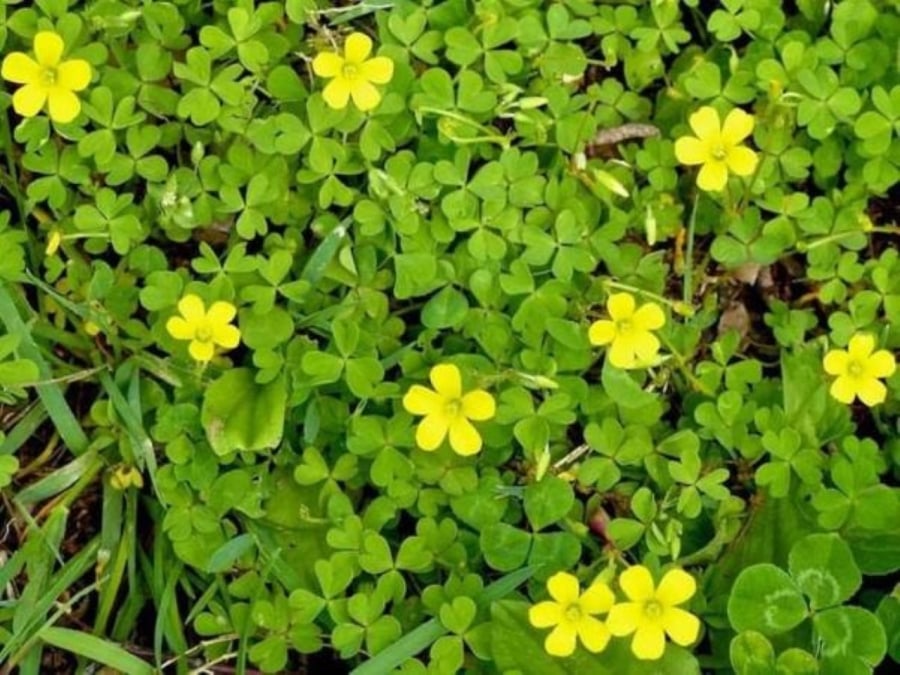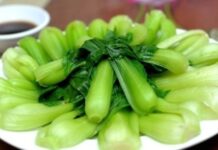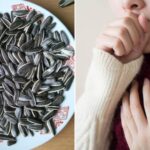1. Characteristics of the Wood Sorrel
In Vietnam, three species of wood sorrel are commonly found: Mountain wood sorrel with white flowers tinged with pink, Wood sorrel with pink flowers, and Wood sorrel with yellow flowers.
All three plants belong to the same family, “Oxalis”, and are edible as vegetables and medicinal herbs. Among these, the yellow-flowered variety is the most commonly found and used medicinally.
Wood sorrel with yellow flowers is a herbaceous plant that creeps and spreads along the ground. It has a pale red stem with sparse hairs. The leaves have long, slender petioles with slightly hairy, trifoliate leaflets that are almost smooth and soft, each with a notch at the base forming a reversed heart shape.
The flowering season is from May to July. The flowers grow in clusters of 2-3, sometimes 4, and are bright yellow in color. The seeds are oval, dark brown, flat, and grow in rows.
The stem and leaves of the wood sorrel contain high levels of oxalic acid, particularly potassium oxalate, giving the plant its sour taste.
During the summer, many people like to pick wood sorrel leaves and cook them with water spinach, using the sour broth as a replacement for lime, sour plum, or tamarind.

Wood Sorrel
2. Medicinal Properties of Wood Sorrel with Yellow Flowers
In traditional Chinese medicine, wood sorrel with yellow flowers is believed to have a sour taste and a cooling nature. It is said to clear heat and dampness, cool the blood, disperse stagnation, reduce swelling, and detoxify. It is used to treat dysentery, diarrhea, jaundice, frequent urination, sore throat, boils, and itching.
In folk medicine, the whole plant of wood sorrel with yellow flowers is commonly used. It is fried to a golden brown, then decocted and consumed as a drink to treat fever, scurvy, and urethritis.
Daily Dosage: 30-50g of fresh whole plant or leaves, or 5-10g of dried plant material.
It is typically consumed as a decoction or powder.
For external use, the decoction or juice extracted from crushed fresh plant material can be used for washing or applying to boils and ulcers.
Note: Individuals with urinary calculi should refrain from consuming wood sorrel.
3. Remedies Using Wood Sorrel
Treat mouth ulcers: Take 60g of fresh wood sorrel, wash and pound into a paste, and extract the juice. Use a cotton ball to apply the juice to the affected areas several times a day.
Lower high blood pressure: Combine 30g of dried wood sorrel with yellow flowers, 10g of Polygala fallax, and 15g of Chrysanthemum indicum. Decoct and consume the brew throughout the day.
Stop nosebleeds: Take fresh wood sorrel, crush it, and insert it into the nostril.
Soothe a sore throat: Chew and slowly swallow 50g of fresh wood sorrel with a pinch of salt.
Treat insomnia: Combine 20g of wood sorrel with yellow flowers and 6g of Equisetum arvense. Boil in water and consume the decoction three times a day.
Relieve acute mastitis: Decoct 30g of fresh wood sorrel and drink the decoction. Apply the leftover plant material as a poultice on the swollen area.
Ease measles in children: Take 9g of dried wood sorrel with yellow flowers and decoct for consumption.
Stop hematemesis: Use 15g of wood sorrel (or 30g fresh) with a pinch of salt. Decoct and consume the brew throughout the day.
The Secret to Cixi’s Eternal Youth: A Daily Dose of a Familiar Vietnamese Delicacy
“Cixi, the formidable Empress Dowager, was renowned for her intelligence and wit, but what truly astonished people was her seemingly ageless beauty, even at the age of 70. Her secret, it turns out, was deceptively simple: a daily indulgence in a delicacy familiar to the Vietnamese. This humble dish held the key to her timeless appearance, a testament to the power of consistent, thoughtful choices in one’s daily routine.”






































